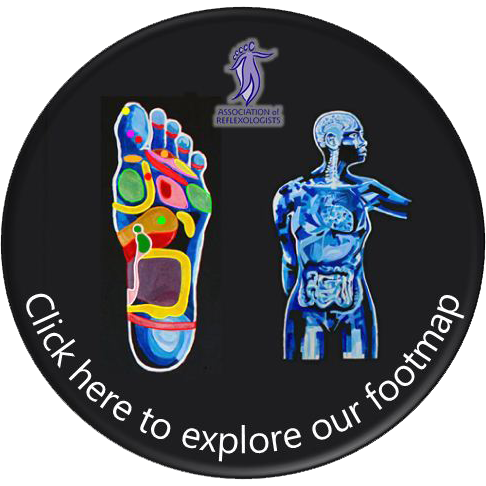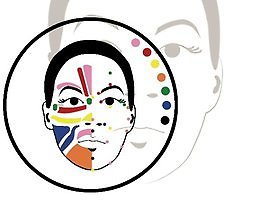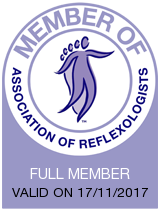Reflexology Maps
Eunice Ingham was the first person to map out the reflexes on the feet as we know them today in the 1930s. Since then there have been many different maps drawn up. In the main they are the same however there are quite a few variations in the more detailed aspects.
People can get a bit hung up on the differences. There can be many valid reasons for the differences so it’s always best to keep all the variations in mind when treating a client. In the end we just use these maps to guide us.
The map I refer to most is one developed by a medical doctor based in Spain called Dr Jesus Manzanares. He has spent the last 35 years researching reflexology from a conventional medical perspective and has come up with some really interesting findings. He developed his map using thousands of patients with medically diagnosed conditions under the age of 40. It is incredibly detailed and has been invaluable to me. Some of the deposits/areas of sensitivity are tiny and if you’re not looking in quite the right place you’re never going to find them!
The Association of Reflexologists have done a great interactive foot map which you will find below. Just click on the image to investigate further.
How does Reflexology Work
There are a number of theories as to how reflexology works but we still don’t know the exact mechanism (and may never). It is probably a combination of all of them. I have listed the ones I feel most relevant below.
Nerve impulse theory: The idea that pressing a point on the foot sends a message to the brain and then on to the corresponding part of the body via the nervous system.
Energy/meridian theory: Illness caused by stagnated energy. Reflexology helps to unblock energy meridians, the same way acupuncture does – 6 of the meridians begin or end in the feet.
Relaxation effect: A lot of pain/discomfort/illness caused by stress. The relaxing effect of reflexology helps this to ebb away.
Placebo effect: This of course plays a part as it does with all therapies.
Does Reflexology work and is there any evidence to back it up?
There is plenty of anecdotal evidence and a growing number of small scale studies showing it's efficacy, however very little in the way of large scale clinical trials.
Small studies from around the world that show that reflexology can:
Reduce pain - 27 studies demonstrated a positive outcome for reduction in pain; e.g. chest pain, kidney stones, osteoarthritis & muscular/skeletal pain.
Improve circulation – of blood and lymph
Induces relaxation - Though EEG measurements of alpha and theta waves, researchers saw that blood pressure was decreased, and anxiety was lowered.
Impact specific organs - ie when massaging the reflex area for kidneys fMRI (functional magnetic resonance imaging) showed an increase in blood flow to the kidneys.
Improve symptoms - In particular, positive changes were noted in kidney functioning with kidney dialysis patients.
Contraindications
Reflexology is a safe, non-invasive treatment and as such there are very few contraindications but it would be wise to avoid reflexology if suffering from any of the following:
A foot injury, blood clotting issues such as DVT, and any life-threatening illness.
Also we are advised to avoid treating during the first trimester due to higher risk of miscarriage, although this is mainly protect us as practitioners.
If in doubt please ask and also consult with your doctor.
Practical questions about the treatment
Does it hurt or tickle?
Many people have memories of their feet being tickled as children and think that they will find a reflexology treatment unbearably ticklish. Rest assured, the pressures and techniques we use are totally different and are not ticklish in any way. There may be an odd point on the feet that is slightly ticklish, though in my experience that shows an area that needs attention and is often painful if you explore it a bit further.
As for a treatment being painful. Pain or sensitivity is one of things we as reflexologists look for. It indicates to us areas that need work. So yes there is an element of pain or discomfort, though we will always work within a clients pain threshold, and the pain is often described as a 'sweet' pain.
What do I need to wear for a treatment and how long does it last?
As a reflexologist I only work the feet and up to the knee, so all you need to do is remove your shoes and socks. Loose fitting trousers or shorts are ideal.
Treatments tend to last around 50-55 minutes though I do offer 30 minute slots as well. Frequency of treatments is key to recovery so I would recommend two 30 minute treatments a week as opposed to one hour long treatment.
Qualifications, Membership, Insurance etc
I qualified from the Central London School of Reflexology in 2004 and have studies numerous post-graduate courses since then including:
Praxis Vertebralis, Facial Reflexology Sorensensistem, Japanese Facial Lifting, Vertical Reflex Therapy, Dr Manazanares Method, Orthopedic Reflexology, Facial Reflexology Bergman method as well as doing courses in fertility and pregnancy.
I am fully insured and a member of the Association of Reflexologists, Professional Reflexology and Vertical Reflex Therapy.
I have also been a member of the Complementary National Healthcare Council though have let my membership lapse. However if you require me to be a member in order for me to carry out treatments then it is a simple procedure for me to renew.
If you have any questions regarding my experience or suitability to treat, please feel free to ask.


